Most guides to Pop ads earning start the same: pop ads definition, a brief history, pops’ advantages, etc. We don’t think it’s something you need right now. So let’s boil down all unnecessary facts and move straight to the gist: how every publisher can make money with Popunders. To make this guide 100% helpful, we asked our expert, Victoria, from Publishers Support, to answer the most frequent questions and concerns. Well, let’s dive in!
Here we’re using one term, “Popunder.” You may also know this ad format as “clickunder” or “on-click pop ads.” We’re not discussing pop-up advertising as it is quite aggressive and brings poorer results. If you’re interested in this type of widget, you should try our super-profitable alternative Interstitial format (available on request on your publisher’s account).
How much do publishers make with Popunders?
Let’s start with the most dramatic issue — the revenue. How much can you earn by placing Popunder codes on your website?
The answer is straightforward — a lot. Popunders remain the most demanded ads among advertisers. They still attract the most high-paying verticals and offers like eShops, Sweepstakes, iGaming, Dating.
As you can see from the payment-proof screenshot below, some publishers thrive with Popunders.
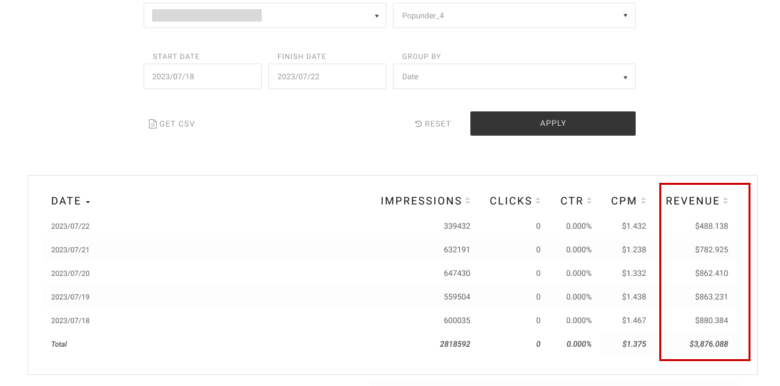
The payouts above are more than impressive — $3,800 in 5 days. But we need to highlight that payouts differ depending on multiple factors, and learning them may help avoid the saddest monetization mistakes. Now we move on to outlining those factors.
Factors that affect your CPM and payouts for Popunder ads
Traffic is a live substance, and it only gets highly paid when meets the advertisers’ requirements. What are they? Here are several factors you should keep in mind while growing organic and paid traffic.
The country you stream traffic from
If you can manage your traffic flow, you’re the winner. You’ve probably heard that Tier-1 traffic gets better CPMs:
- The United States (USA);
- Canada (CA);
- The United Kingdom (GB);
- Australia (AU).
The COVID’s after effects have reshaped markets worldwide. More and more users have started shopping online. With mobile Internet speed showing explosive growth, some countries are now becoming top online consumers. South Africa (ZA), India (IN), Indonesia (ID) and Kenya (KE) are among them. Latam is another hotspot. With its evolving economies, Latin America attracts thousands of advertisers willing to promote there and pay highly for ad views, clicks, and conversions.
Seasonality
Here you have very little to manage — just get ready to offer a great number of impressions when the sales or holiday season comes: Black Friday, Cyber Monday, Christmas, and New Year celebration, local holidays, and sales.
Device and traffic type
Mobile traffic is getting more expensive, and many advertisers are ready to pay for it. If you can stream traffic from a specific mobile operator, advertisers will definitely keep you in their whitelists.
Conversions and clicks
You get paid for ad impressions, but every advertiser needs something more than just an ad view. They look for app installs, sign-ups, purchases, and orders. The key to higher gains and truly profitable Popunder monetization is eCPM, the effectife cost-per-thousand impressions. With Adsterra, you get increased payouts when the traffic you send returns conversions and clicks.
The share of new/returned users
Advertisers are willing to pay for quality traffic, but only if it is refreshing continuously. It is excellent if the share of new users is ~30% or more.
Audience profile or website niche
The amount of from social networks (esp. Facebook) has doubled in the past two years. Publishers sending social traffic from Facebook, Twitter, TikTok enjoy the highest CPM rates. Those who own streaming platforms are earning a lot these days. Some of the most profitable niches: streaming, movies and TV series, anime, niche or XXX traffic, new aggregators, torrents.
Popunder frequency
Ad frequency is a decisive factor that can make your CPM soar or drop. Publishers who monetize websites with Adsterra can experiment with ad frequency to reach more significant revenues.
Frequency Сapping is the number of Popunders you display for each unique visitor within 24 hours. For instance, with 1/24 frequency, each unique user will only see one Popunder in 24 hours.
Let’s discuss it a little more in detail.
How to increase revenue by changing Popunder frequency?
Let’s say you’re sending us 100,000 unique users and want to display Popunders not more than 1 time per 24 hours. We have 3 advertisers that want to get your traffic: their bids are $2, $1.5, and $1. Adsterra will connect you to the highest-paying one, and you will get $200 revenue with the CPM of $2.
Another example with 3/24 frequency. This time you will get paid by all three advertisers because each user is now able to see 3 Popunders within 24 hours. Your revenue will grow up to $360. However, your CPM will be lower, $1.63. Therefore, the CPM rate is not ultimately equal to the income.
Adsterra offers you a default setting of 4 Popunders in 2 hours with 10 seconds delay between them. For the majority of websites, it is the ideally balanced frequency that doesn’t annoy users.
You can ask to change it by asking our Support team in the live chat. We’re online 24/7 for you 🙂
What CPM can publishers get with Adsterra Popunders?
On Adsterra, publishers earn money with Pop ads with a dynamic eCPM rate. It is calculated and updated automatically and depends on advertisers who place CPA and CPM bids. How does it work?
First, our algorithms assess how many conversions your traffic can bring (the cost-per-action or the CPA pricing). A conversion means an action: a sign-up, an opt-in, an order, a subscription, a purchase. If users from your website complete many actions, we send you more CPA campaigns, and you get significantly higher payouts. If not, we add more CPM-based campaigns when advertisers pay only for ad impressions. And again, if you stream quality impressions, your CPM will be solid.
Examples of profitable Popunder monetization
Pops are one of the most used means of making money online. Their codes don’t occupy any web space, and the advertising landing pages opens up when a users navigates a publisher’s website. But how about real earnings? What are real-life examples of Popunder monetization? Adsterra publishers can help you with getting a clue to this.
Many bloggers, content creators and producers, programmers and influencers are making money with Pops. You have full access to their success stories right now. For instance, learn how a content creator Achile Anne creates viral news and monetizes with Popunders, Banners, and Social Bar. Another great story is told by a blogger & website developer Muhammad, who managed to mix Popunders with Quora traffic.
Which websites should use Popunders for monetization?
Popunders don’t require any ad space, so they’re friendly to your website design and structure. They open in a new tab or browser window, not blocking or overlapping the current content. That’s why we can assure you that pop ads fit almost any website.
Top website niches for profitable Popunder monetization
- Movies
- News
- Streaming
- Online tools
- Music
- File converters
- Anime and games
- Downloads
- Books
Some website niches are sensitive to ads, and we recommend testing any advertising format before running it full blast. Those niches are yoga and wellness, religion, parenthood, any paid content (available on subscription).
More website-friendly and CPM-boosting formats
How to place Popunder ads on a website and start earning?
You can place Adsterra Popunder on any website, even if it is a one-page web service. Let us walk you through the main steps so that you could start making money today.
First, you will need to request the Popunder code and add it to your web page according to our instructions. Let’s get it done!
Step 1. Request Adsterra Popunder code / script
You can apply for a Popunder code if you’re a registered publisher. So please sign up now and check your inbox because we will send you a verification email. You can check this guide to getting started with Adsterra for more details.
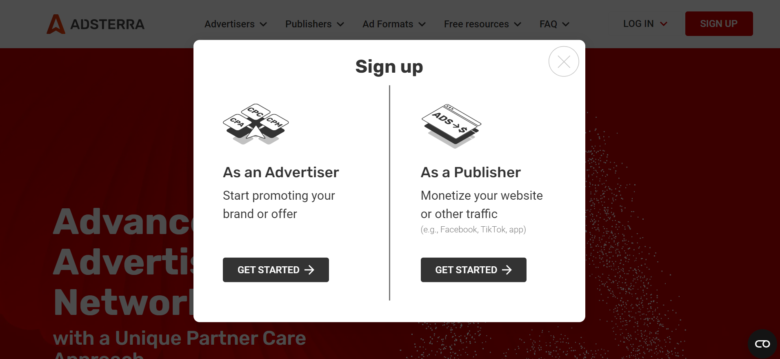
- From your account, navigate to the Websites page. Click ADD WEBSITE.
- In a new window, fill out all necessary fields and pick Popunder in the Available Ad Unit.
- Click ADD.
- Now, we will need a couple of minutes to verify and approve your website. The next step is to get and copy your Popunder script.
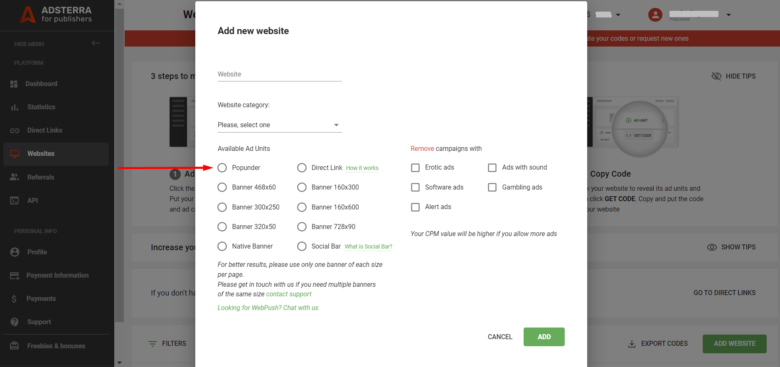
Explore all Adsterra moneymaking capacities. Add your website or mobile app/APK today to start getting passive income!
Step 2. Get Adsterra Popunder ad code / script
- On your Websites page, you can check whether your website and Popunder code have been approved. If you see the status Approved, click All codes — Get code. And then copy the code.
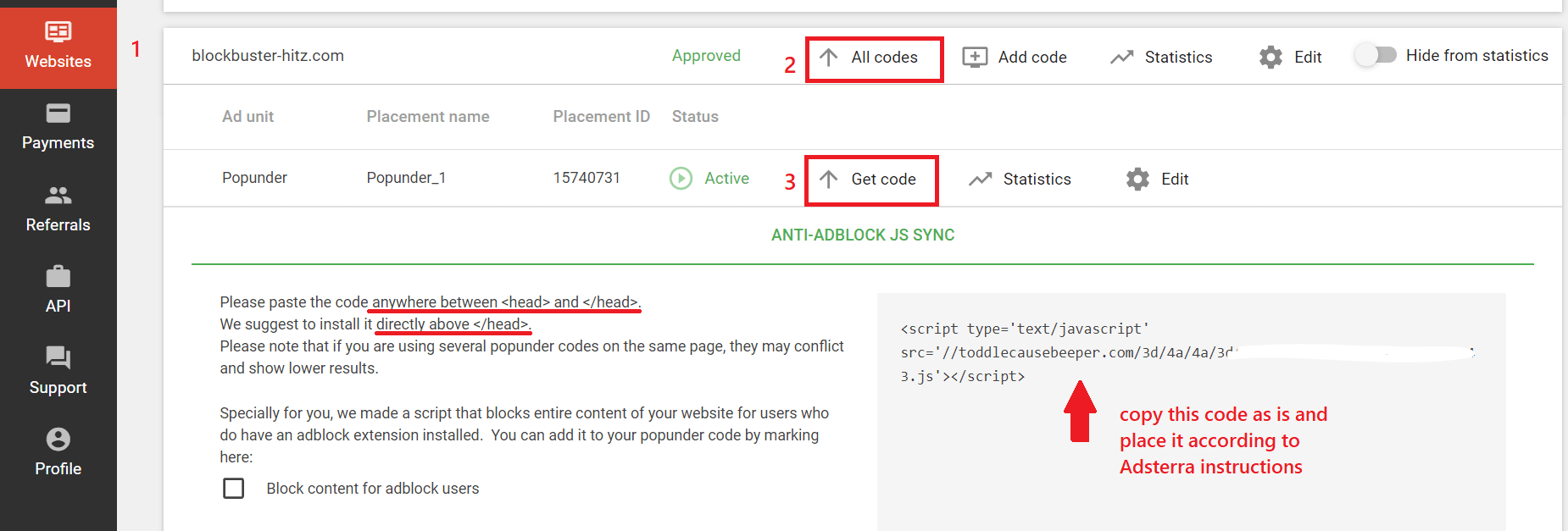
- There is one more way you can get the code. Check your inbox and find our email (subject: Adsterra Network — Your domains were approved). Follow the link to copy the script.
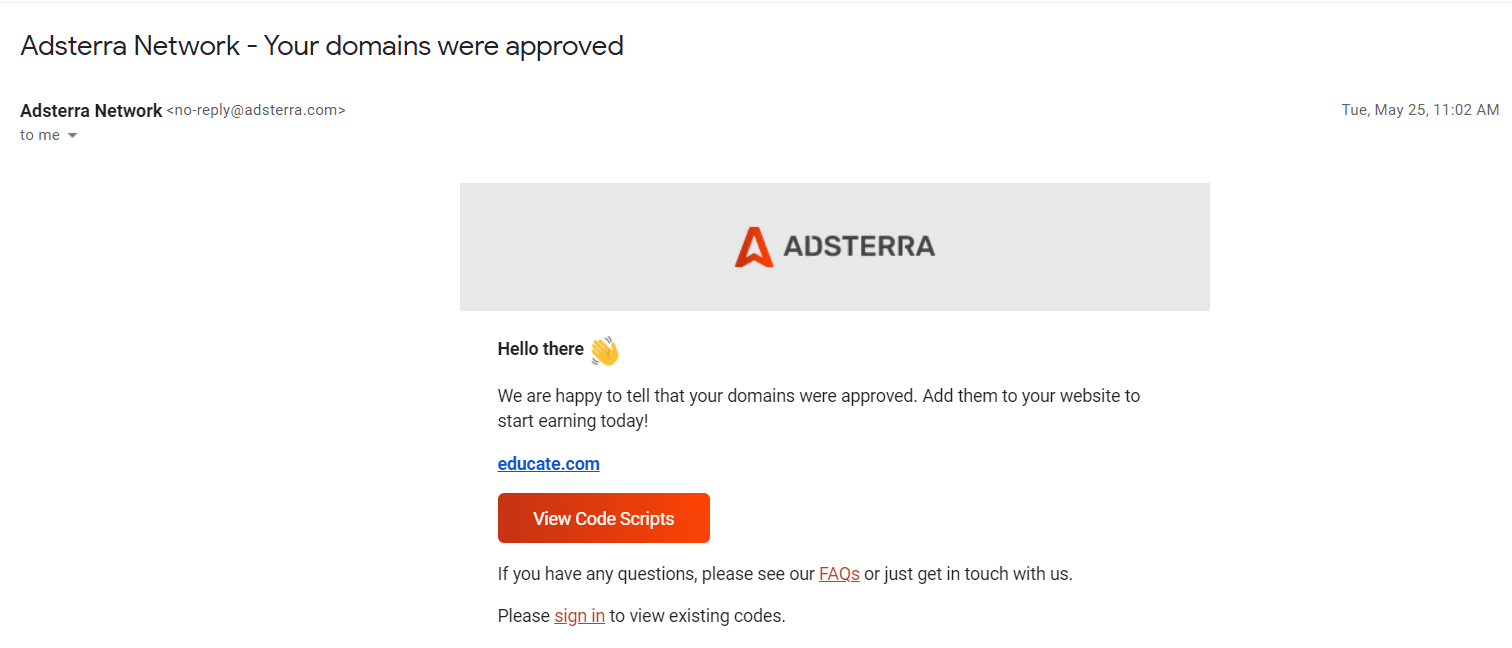
Step 3. Put Popunder on your website and get paid
Now you’ve got a Popunder script copied to the clipboard. It’s time to find out where to place it. There are too many website building platforms to describe the ad code installation on each of them. But usually, the flow is the same… and pretty easy-to-run.
Put a Popunder code on static HTML pages
If you don’t have any CMS to edit the website source code, you will have to open the HTML view and paste the code before the closing “</head>” tag. Popunders are the only ads that must be placed between the two “<head>” tags.
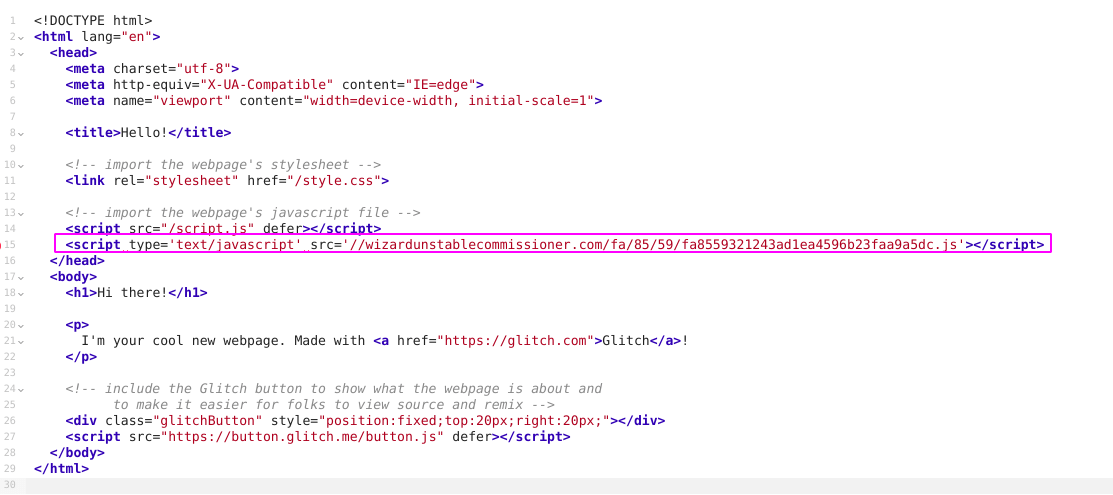
Place a Popunder WordPress code with the Theme Editor
On a WordPress-based website, you will also need to place the code in the “<HEAD>” section. The easiest way to find it is to edit your WP theme. Let’s see how you can do it.
- From your Admin panel, click Appearance, and select Theme Editor.
- On the Theme Editor page, you need to find the Theme element to paste your Adsterra Popunder code. All elements are listed in the Theme Files field.
- For placing a Popunder code, choose the element that contains the “<HEAD>” tag. Usually, it is the Theme Header file. Open it and paste the code snippet before the closing “</HEAD>” tag.
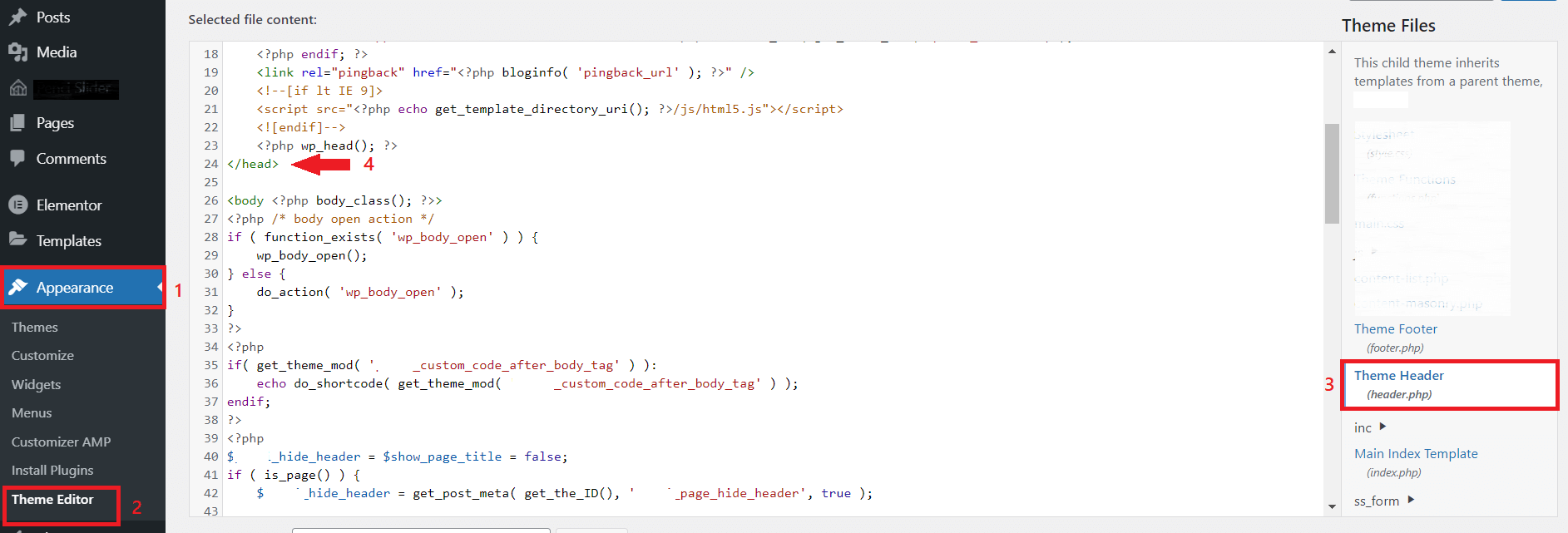
An alternative and more safe way to open the header part of the website is with theme customization. Look if this option is available. Click Appearance → Customize. In the list of theme elements, find one that contains the words “header.” There must be an option to add a custom code inside the “<HEAD>” tag. But we recommend you read your theme’s provider documentation first.
Add a Popunder WordPress code using a plugin
Sometimes, it is much easier to use a WP plugin to seamlessly add any code to the website’s header and footer. One of those is Headers and Footers.
To activate it, you need to navigate to the Plugins tab and click Add new. Type in the name of the plugin we recommend or find an alternative. Then, click Install now and Activate after the installation is finished.
The plugin will appear in your Settings tab. Click on it and choose your plugin to simply paste the Popunder code.
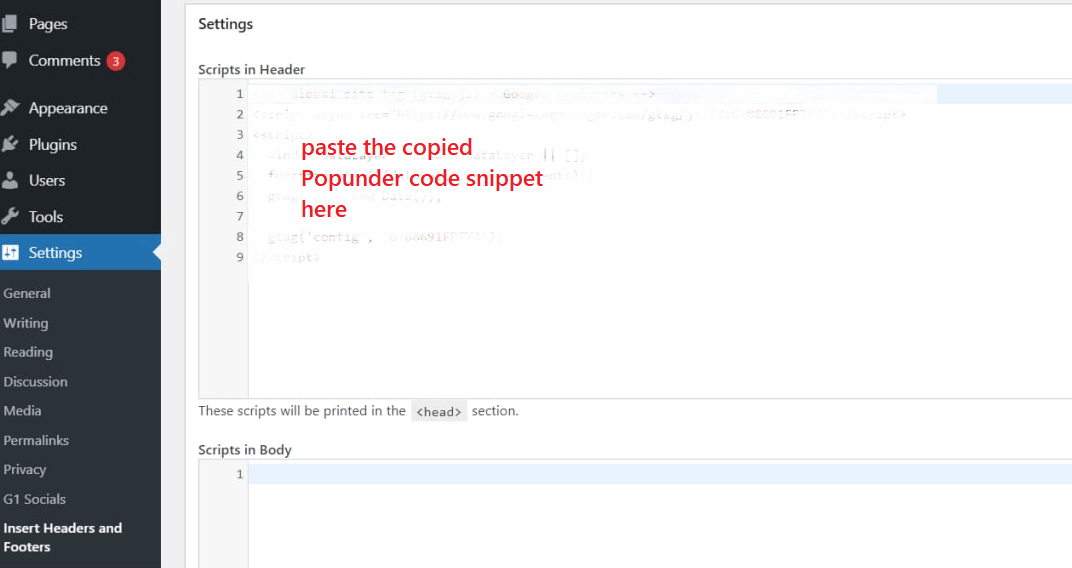
Add a Popunder code to Blogger
Blogspot or Blogger is a free platform for running blogs, and many publishers use it to monetize traffic. To put an Adsterra Popunder here, you will need to find the header part. It is better to use the visual editor tool.
- Navigate to Layout and click Add a gadget.
- Select HTML/JavaScript gadget from the list and the Edit icon.
- Paste the code snippet into the Content field and click Save. Make sure the gadget you chose is in the Header part. You can drag and drop gadgets between various parts of the layout.
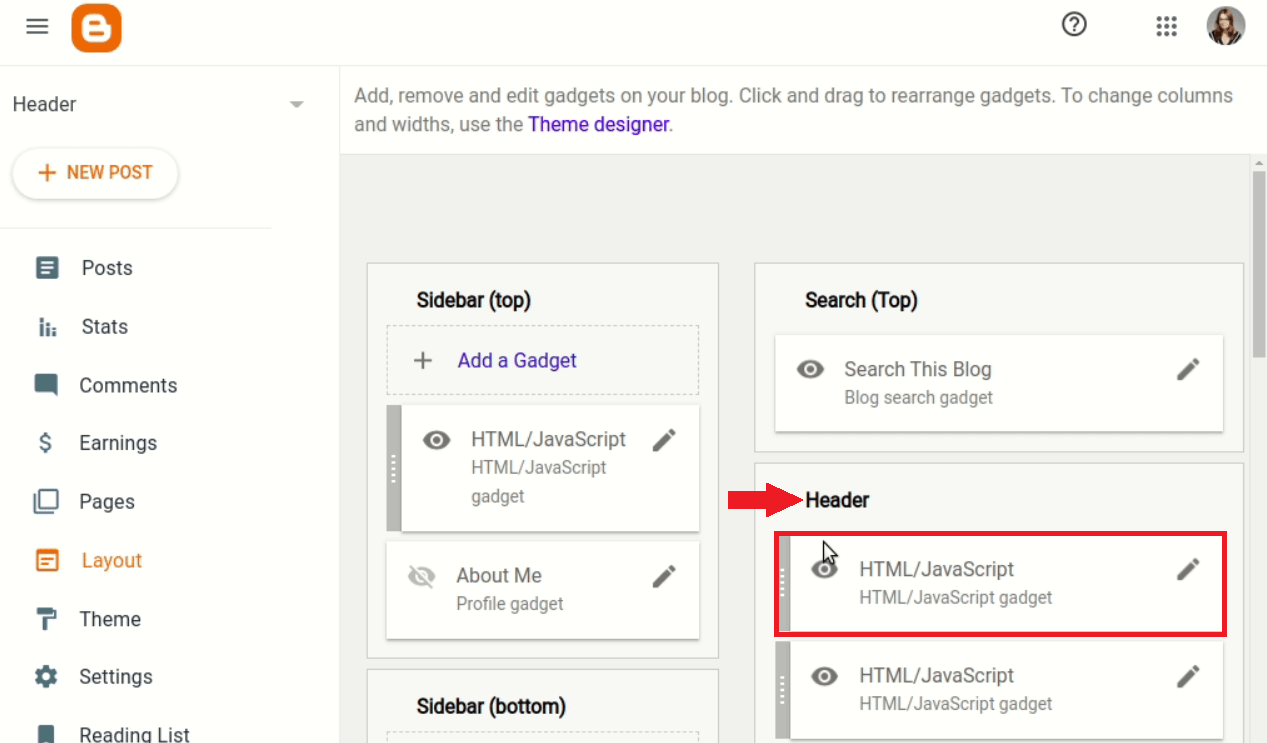
Ending up this section, we would like to highlight that hundreds of insights and answers are waiting for you in the Adsterra Helpcenter. Here you will find the recommendations for choosing the suitable ad unit, or learn how to put ads with Elementor.
If you’re using CloudFlare, Adsterra Popunder ads may not work on Chrome and other browsers: we have a ready-to-use solution to that.
How to combine Popunder ads with other formats for better monetization?
Popunders are a pretty straightforward ad type, so could you use any additional advertising codes, or will it be too much?
Actually, you could and should! But mind the website niche and format while combining ads.
Our recommendations will be:
- News websites: it is better to place Pop ads along with Native Banners.
- Service websites (converters, shorteners, torrents): you can use Social Bar, pops, and banners.
- Blogs and educational websites: it is better to start with native ads. As for Popunders, test them first, and if your readership reacts benevolently, you’re free to go ahead!
- Movies and streaming platforms: mix Popunders with Banners (exclude ads with sound). Learn more about monetizing a movie website.
Conclusion
Regardless of your traffic volume, your profitable Popunder monetization strategy is something you can start developing right now. It’s true that the more users attend the website, the higher your CPM is, but remember that we consider the quality of traffic. So take your chance and join Adsterra as a publisher. Our managers will assist in choosing the best ad format that matches your niche and prompts many views.
